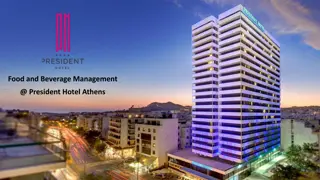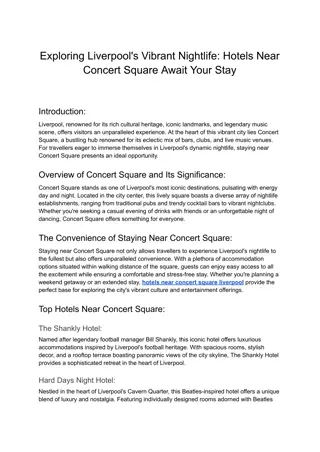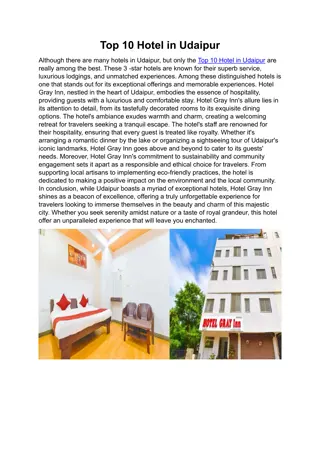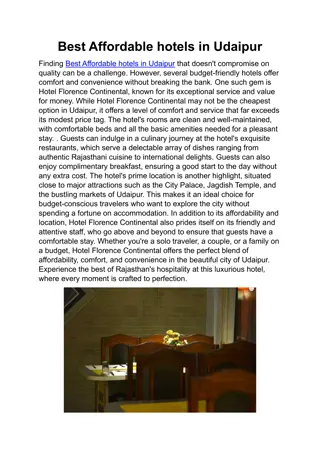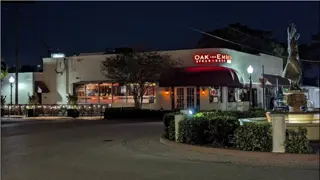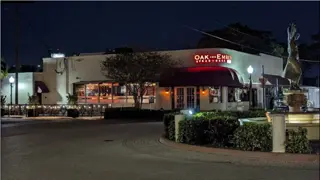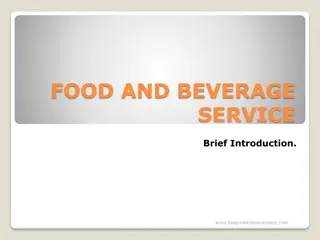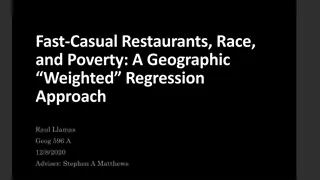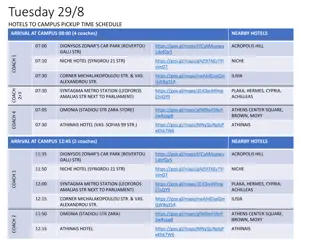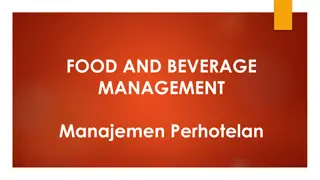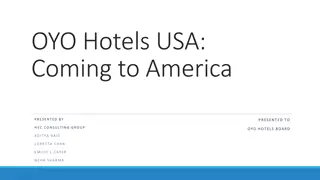Key Differences in Food and Beverage Management for Hotels and Restaurants
Understanding the profitability and marketing-related disparities between hotel and restaurant food services. Room service operations outline concerns and menu planning factors unique to hotels. It delves into cost allocation, accessibility, service offerings, and quality maintenance, shedding light on the complexities faced by hospitality establishments in managing F&B services effectively.
Download Presentation

Please find below an Image/Link to download the presentation.
The content on the website is provided AS IS for your information and personal use only. It may not be sold, licensed, or shared on other websites without obtaining consent from the author.If you encounter any issues during the download, it is possible that the publisher has removed the file from their server.
You are allowed to download the files provided on this website for personal or commercial use, subject to the condition that they are used lawfully. All files are the property of their respective owners.
The content on the website is provided AS IS for your information and personal use only. It may not be sold, licensed, or shared on other websites without obtaining consent from the author.
E N D
Presentation Transcript
FOOD AND BEVERAGE MANAGEMENT Manajemen Perhotelan
PROFITABILITY Meeting 4 Manajemen Perhotelan
Profitability Differences: Hotel & Restaurant Foodservices Profitability = Revenue - Expenses Profit amounts generated by restaurant F & B is relatively easy to calculate. The process of allocating revenues and expenses applicable to F & B services in a hotel is more difficult. (alokasi biaya) Costs of F & B sales is generally higher in a restaurant than in hotel. Hotel s bottom line profit from F & B sales is likely to be lower than a restaurant s. Payroll costs (or fixed labor costs) are higher than in a restaurant.
Marketing-related Differences: Hotel & Restaurant Foodservices Restaurants: locations easily accessible to potential guests Hotels: locations most accessible to guests desiring lodging accommodations Location within the community Restaurants: locations easily accessible to potential guests Hotels: locations most accessible to guests desiring lodging accommodations Location within a hotel For hotels, F& B service is viewed as an amenity or secondary Menu (sale of guestrooms is primary objective)
Room Service Operations: Profitability Concerns Relatively few properties generate profits from room service Very high labor costs High expenses incurred for capital costs Why lose money? Service to guests - some guests select hotels based on room service availability Why offered? Impacts hotel rating High expenses incurred for capital costs - Delivery carts / warming devices Offer hospitality suite business Provide hosted events How to offset losses?
Room Service Operations: Menu Planning Factors Less likely to oversee room service food quality Must offer products maintaining quality during holding and transportation to guest room (example: problems with omelet & French fries) Quality Concerns Cross-Selling Advertising availability of other hotel services - dinner menu providing info about Sunday brunch Language barriers for international guests - uses of pictures and multi-lingual menu descriptions Menu Language Clearly state ordering-requirements (kebijakan suatu negara) - minimum order charges / mandatory tipping policies
Room Service Operations: Operating Issues An inaccurate room service order cannot be corrected quickly. A minor problem in room service may impact guest s perceptions about the entire lodging experience. (bad effect) Guest placing order / order taker / room service production-service staff / room service staff Abbreviations should be clearly understood by order taker and food production staff (singkatan harus jelas) Communication Improving the accuracy of room service orders -electronic cash register (ECR) / point-of-sale terminal / remote printer Technology Opportunities for upselling are overlooked (diabaikan) Upselling increases guest check average (A+ to A++ etc) Upselling Technique
Room Service Operations: Within-Room Service Training issues for room service attendants Explaining procedures to retrieve room service items Asking guests where room service meal should be set up Presenting guest check and securing payment Opening wine bottles (where applicable) Providing an attitude of genuine hospitality
Banquet Operations: Profit Opportunities Well-planned banquets can be profitable! Banquet menu has higher contribution margin. - banquets frequently celebrate special events Forecasting & planning production, service and labor are relatively easy. - formal guarantee is made - less likelihood of overproduction of food with subsequent waste Beverage sales from hosted or cash bars increase profit. - capable of increasing alcoholic beverage sales Increasing market share of the community s banquet business Increasing property s profitability
Banquet Operations: Menu Planning Factors / concerns for planning banquet menus Guest preferences Ability to deliver desired quality products Availability of ingredients required to produce the menu Production / service staff with appropriate skills Equipment / layout / facility design issues Nutrition issues Sanitation issues Peak volume production / operating concerns Ability to generate required profit levels


